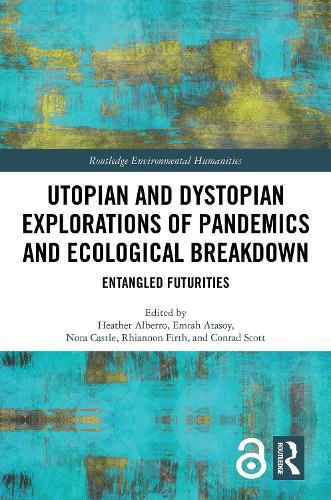Readings Newsletter
Become a Readings Member to make your shopping experience even easier.
Sign in or sign up for free!
You’re not far away from qualifying for FREE standard shipping within Australia
You’ve qualified for FREE standard shipping within Australia
The cart is loading…






This edited collection, which is situated within the environmental humanities and environmental social sciences, brings together utopian and dystopian representations of pandemics from across literature, the arts, and social movements.
Featuring analyses of literary works, TV and film, theater, politics, and activism, the chapters in this volume home in on critical topics such as posthumanism, multispecies futures, agency, political ecology, environmental justice, and Indigenous and settler-colonial environmental relations. The book asks: how do pandemics and ecological breakdown show us the ways that humans are deeply interconnected with the more-than-human world? And what might we learn from exploring those entanglements, both within creative works and in lived reality? Brazilian, Indian, Polish, and Dutch texts feature alongside classic literary works like Defoe's A Journal of a Plague Year (1722) and Matheson's I Am Legend (1954), as well as broader takes on movements like global youth climate activism. These investigations are united by their thematic interests in the future of human and nonhuman relationships in the shadow of climate emergency and increasing pandemic risk, as well as in the glimmers of utopian hope they exhibit for the creation of more just futures.
This exploration of how pandemics illuminate the entangled materialities and shared vulnerabilities of all living things is an engaging and timely analysis that will appeal to environmentally minded researchers, academics, and students across various disciplines within the humanities and social sciences.
The Open Access version of this book, available at http://www.taylorfrancis.com, has been made available under a Creative Commons Attribution-Non Commercial-No Derivatives (CC-BY-NC-ND) 4.0 license.
$9.00 standard shipping within Australia
FREE standard shipping within Australia for orders over $100.00
Express & International shipping calculated at checkout
This edited collection, which is situated within the environmental humanities and environmental social sciences, brings together utopian and dystopian representations of pandemics from across literature, the arts, and social movements.
Featuring analyses of literary works, TV and film, theater, politics, and activism, the chapters in this volume home in on critical topics such as posthumanism, multispecies futures, agency, political ecology, environmental justice, and Indigenous and settler-colonial environmental relations. The book asks: how do pandemics and ecological breakdown show us the ways that humans are deeply interconnected with the more-than-human world? And what might we learn from exploring those entanglements, both within creative works and in lived reality? Brazilian, Indian, Polish, and Dutch texts feature alongside classic literary works like Defoe's A Journal of a Plague Year (1722) and Matheson's I Am Legend (1954), as well as broader takes on movements like global youth climate activism. These investigations are united by their thematic interests in the future of human and nonhuman relationships in the shadow of climate emergency and increasing pandemic risk, as well as in the glimmers of utopian hope they exhibit for the creation of more just futures.
This exploration of how pandemics illuminate the entangled materialities and shared vulnerabilities of all living things is an engaging and timely analysis that will appeal to environmentally minded researchers, academics, and students across various disciplines within the humanities and social sciences.
The Open Access version of this book, available at http://www.taylorfrancis.com, has been made available under a Creative Commons Attribution-Non Commercial-No Derivatives (CC-BY-NC-ND) 4.0 license.